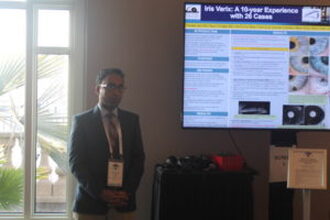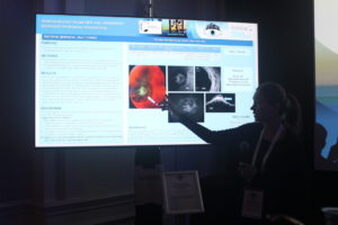Day 3: Live From the ISOO 2019!
Day 3 at the ISOO: Melanoma, Other Intraocular Cancers, and Basic Retinoblastoma Science
Every two years, eye cancer specialists worldwide convene at the International Society of Ocular Oncology Conference in order to review latest research and encourage international collaboration within the field of ophthalmic oncology.
For details on the ISOO, read more here.
Every two years, eye cancer specialists worldwide convene at the International Society of Ocular Oncology Conference in order to review latest research and encourage international collaboration within the field of ophthalmic oncology.
For details on the ISOO, read more here.
|
Dr. Puneet Jain returned to give us some insight on iris varix by presenting his paper Iris varix: 10-year experience with 28 eyes, published alongside Dr. Paul Finger during his Eye Cancer Foundation fellowship. The study began with the intention to more clearly define iris varix, consistent characteristics, imaging findings, and note any consistent change that might occur with observation. The results showed that iris varix is “primarily located in the inferotemporal quadrant, not associated with dysmorphic pupillary findings, progression, secondary glaucoma, or malignancy.” Essentially, “iris varices were benign vasculopathies with no associated ocular or vision-related morbidity.”
|
|
Dr. Ekaterina Semenova's poster presentation.
Why are some cases naturally suppressed by the immune system? Dr. Ekaterina Semenova raised the question, noting five cases in which choroidal melanoma in the patient had spontaneously regressed in her paper Spontaneously Regressed and Apparently Dormant Choroidal Melanomas, also published alongside Dr. Finger. She opened up discussion to the audience, though consensus was that this would be an interesting topic for future research in order to determine the cause. Now that such cases have been documented, we have this data to look back on and, hopefully, make additions to. |
|
Finger’s Slotted Plaques was recognized in Dr. Abhilasha Maheshwari presentation, A 12-Year Study of Slotted Eye Plaque Radiation for Choroidal Melanoma: Near, Touching, or Surrounding the Optic Nerve.
Over a decade’s worth of data was analyzed and slotted plaques were found to be very effective and resulted in good patient outcomed for patients whose tumor lies close to the optic nerve. These plaques offer more proper positioning of the plaque, allowing radiation to the entire melanoma plus a 2-3 mm margin. Dr. Maheshwari concluded that even after 12 years, “slotted plaque radiation therapy resulted in high rates of local tumor control and vision and eye retention.” |
That's all for today's ECF highlights! Day 4 will be fully dedicated to retinoblastoma. Stay tuned!
To help sponsor fellowships and fellow research, donate to The Eye Cancer Foundation at www.eyecancercure.com/donate-now.html.
Receive the latest news and opportunities from The Eye Cancer Foundation. Please fill out the form below.
To help sponsor fellowships and fellow research, donate to The Eye Cancer Foundation at www.eyecancercure.com/donate-now.html.
Receive the latest news and opportunities from The Eye Cancer Foundation. Please fill out the form below.





